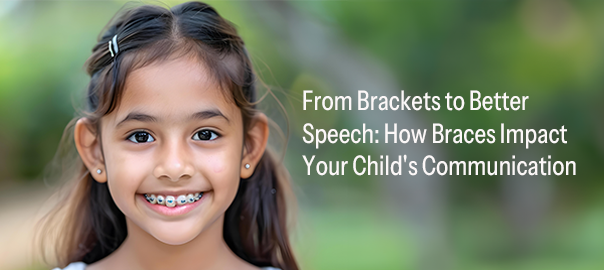
From Brackets to Better Speech: How Braces Impact Your Child’s Communication
Braces and Speech Development in Children
When you think of braces, you probably picture a straighter smile. But did you know that orthodontic treatment can also play a crucial role in your child’s speech development? Let’s explore how braces can help shape not just your child’s teeth, but their words as well.
The Teeth-Speech Connection
Our teeth do more than just chew food – they’re essential for clear speech. The position of teeth and alignment of the jaw significantly impact how we form sounds. Common dental issues like overbites, underbites, crossbites, and crowded teeth can lead to various speech problems, including:
1. Lisping: Difficulty pronouncing “s” and “z” sounds
2. Articulation issues: Trouble with “d,” “th,” or “r” sounds
3. Slurred speech: General articulation problems due to lack of space or incorrect tongue position
4. Whistling: Air escaping through gaps between teeth
5. Mispronunciation: Difficulty with certain words due to tooth gaps or missing teeth
How Braces Can Help
Orthodontic treatment addresses these dental issues by aligning teeth and jaws properly. This creates the ideal oral environment for clear speech production. Braces can:
1. Close gaps between teeth
2. Align crowded teeth
3. Correct bite issues (overbites, underbites, and crossbites)
4. Create proper space for the tongue
By optimizing teeth and jaw alignment, braces can significantly contribute to improved speech clarity.
The Power of Early Intervention
Catching and addressing speech-related dental issues early is crucial. Children’s teeth and jaws develop rapidly, making early assessment vital. Orthodontists recommend an initial evaluation around ages 6-8 to plan the right treatment during this formative phase.
Early intervention helps to retrain muscles and habits. This potentially prevents the need for more invasive treatments later on.
A Team Approach: Orthodontics and Speech Therapy
Often, addressing speech issues requires a collaborative effort. Orthodontists frequently work with speech therapists and oral myo-functional therapists to provide comprehensive care. While braces address structural issues, these specialists can help with:
1. Targeted exercises to balance facial muscles
2. Correcting tongue placement and swallowing patterns
3. Addressing habits like mouth breathing
This combined approach aims at simultaneously addressing:
1. the physical structure of the mouth
2. the functional aspects of speech
Braces do much more than just creating a beautiful smile. By addressing dental issues impacting speech, it helps your child communicate clearly & confidently. They play a much greater role in your child’s speech development than you are able to realize. When in doubt about your child’s speech or dental alignment, feel free to reach out to our experts here at Clove. Remember, early intervention makes a world of difference in shaping your child’s words and smiles!
Leave a Reply
Leave a Reply
Explore More Similar Posts
Explore More Blogs


Leave a Reply